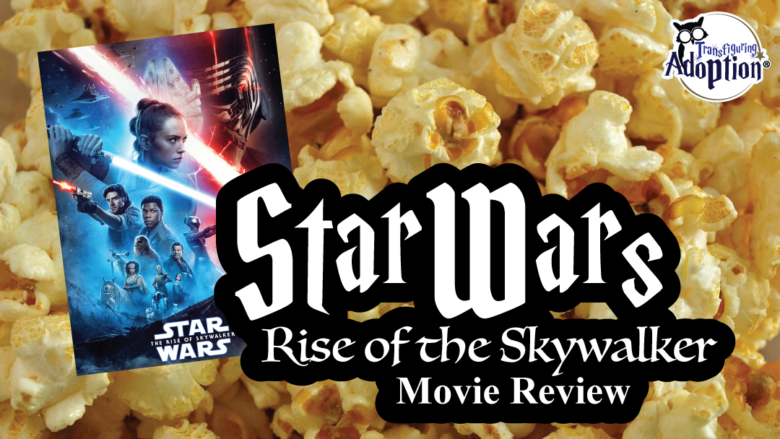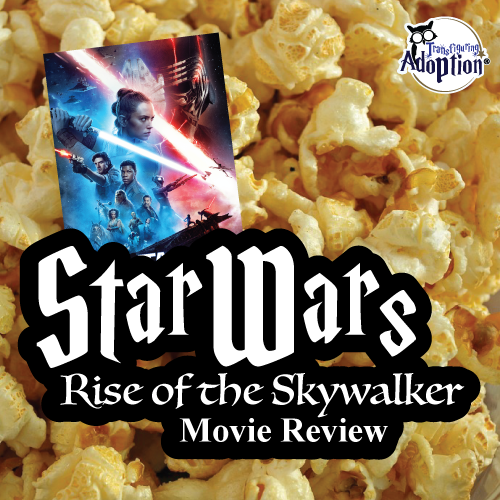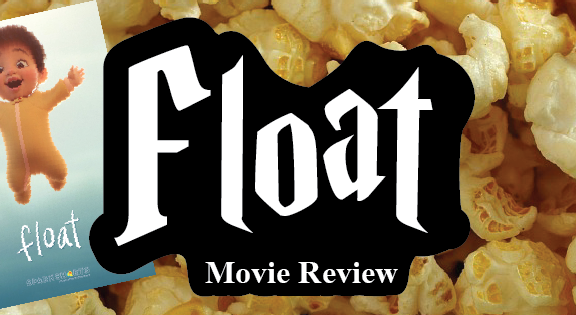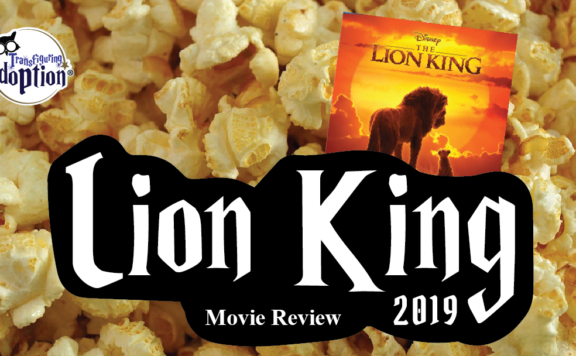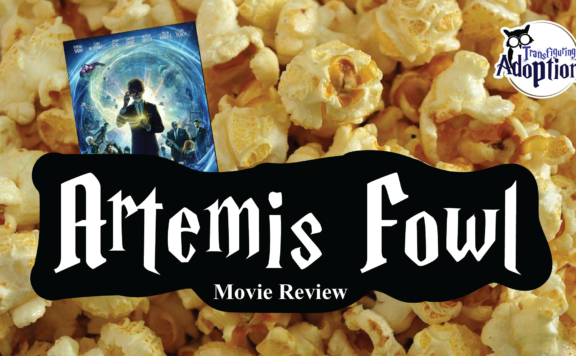Grade:
Transfiguring Adoption awarded this book 4 Hoots out of 5 based on how useful it will be for a foster/adoptive family. [Learn more about our Hoot grading system here]
Movie Info:
- Rating:
PG-13 (for sci-fi violence and action) - Genre:
Action & Adventure, Science Fiction & Fantasy - Runtime:
155 minutes - Studio:
Walt Disney Pictures
From the Synopsis of Star Wars: Episode IX – The Rise of Skywalker (2019) by Walt Disney Pictures:
“No one’s ever really gone… Rey’s journey continues and the Skywalker saga concludes in Star Wars: The Rise of Skywalker, coming December 2019.”
Transfiguring Adoption’s Overview:
The much anticipated close to the (reportedly) final trilogy for the Star Wars franchise has finally arrived. With all of the buzz for old and young fans alike you would have to be living on Ahch-To have not heard about Star Wars: Episode IX – The Rise of Skywalker. This movie promises to be the movie of the season and will probably break several records on opening weekend and through the holiday season.
Parents should note that in spite of the franchise often catering to the imaginations of little ones that this film is PG-13, and for great reason. This film should probably be screened by a parent before a child younger than 13 watches this one. I know that’s probably hard as there are many young Padawan that want to see Rey, Finn, Poe, and BB-8 through to the end but there are some very violent and emotional scenes in this film that would be difficult for children whether they have experienced traumatic losses from time in foster care or not. However, if you are the caregiver to a teen and wish to watch the film with them and talk after this could be a great film to kick off winter break with!
** Spoilers Could Be Ahead **
How Is This Relevant To Adoption & Foster Care?
I want to start off by saying I think that every movie or series in the Star Wars has relevance to Adoption and Foster Care. Between the past movie’s having characters literally orphaned or being fostered as padawans there is plenty of direct connections to the challenges and ascensions of caring for foster youth. However, Star Wars: Episode IX – The Rise of Skywalker is interesting in that it targets multiple characters’ experiences with grief and loss related to separation from a primary attachment as well as the process of moving forward with found family (and identity, especially in the newly named Rey Skywalker’s case). So with this in mind a child is going to have more characters to potentially see themselves within and identify with. As Poe Dameron says when rallying the Rebellion for the final battle: “They win by making you think you are alone. There are more of us.” Every child or teen’s experience with the grief and loss that inevitably comes with foster care and adoption may be unique, but they are certainly not alone in the overwhelming emotions and Sith-like darkness that burdens their soul and this is where Star Wars: Episode IX – The Rise of Skywalker has the potential to be powerful.
Now, I’m sure there are enough discussion points to develop an entire book on this movie alone but I will be focusing on just a couple of high points relating to the human desire to know about our family of origin, breaking generational cycles, and found family and identity. So with that disclaimer, let’s force leap in with light sabers ready.
Discussion Points:
- Attachment with Family of Origin
Human beings are socially and emotionally formed in the context of relationships. If you think about all your quirks and habits, they were not created in a vacuum without influence. Attachment is a lasting bond that surpasses time and space, formed over time with serve and return communication. A baby feels the displeasing sensation of hunger and cries out, soothed when a parent response with a bottle and providing relaxation from meeting the expressed need. Over time, if a parent continues to respond more often than not, that will result in trust. Trust results in Security, which eventually becomes Attachment. Even if Attachment is somewhat disorganized the child will still long for what is familiar within those primary relationships. This is why children will continue to love and long for a parent even if there are years of abuse or neglect and why caregivers should be mindful about how they talk about a child’s family of origin. This can be seen in Rey’s desire to learn about her family of origin, Kylo Ren/Ben struggling with his identity between Skywalker/Solo and Darth Vader’s legacy, and in several characters that are curious about their origins after being kidnapped for bolstering Storm Trooper numbers. - Breaking Generational Cycles
In my line of work, I have not worked with a parent that one day woke up and said “I want to abuse my child.” Usually abuse and neglect cases are much more complex than having an Emperor Palpatine plotting in the corner. Many times a parent is bound up in issues related to abuse or neglect they themselves have suffered. Or a parent could be lost in substance abuse or mental illness (or both). A parent may be carrying out the parenting style they were taught by their own parents and truly think they are doing what is best for the child. A parent could lack the resources and knowledge to get what they need. In my experience there is often a combination of many of those things that leads to a child needing to be brought into care for safety reasons. Children may find themselves struggling with similar issues as well whether due to what they learned in their family of origin in how to cope with challenges or even genetic predisposition, and struggle even more to break away from what is familiar. This can be seen in both the Skywalker/Solo clan and the Palpatine bloodline in Star Wars: Episode IX – The Rise of Skywalker. - Found Family and Identity
This is the piece that stands out for Star Wars: Episode IX – The Rise of Skywalker compared to other movies in the franchise. By the end of the film Rey, Pod, and Finn each find their way into new identities and a family with one another after the end of the war. Rey and Ben each have the chance to change the visions they considered set in stone by fate and become the best versions of themselves. Ben portrays this in his self-sacrifice to finally fulfill the Skywalker prophecy by bringing balance to the Force and leaving behind the legacy of Kylo Ren and Vader. Rey becomes Rey Skywalker, taking the name of her foster family (Luke and Leia) and forges a new path with her new neutral light saber, colored yellow.
Cautionary Points:
- There is a LOT of Violence
This starts within the first minute of the film and continues until almost the very end. Violence includes stabbings, light saber battles with blood, ship wrecks with explosions and passengers thrown from vehicles, the use of laser guns in hand and on ships, beasts eating humanoid characters, a spy being beheaded and having the head thrown on a table, the Force being used to choke people, murders outside of battle sequences, the use of the Force in the form of lightening to cause harm/kill accidentally and purposefully, blown up planets, a droid that was implied to be abused by a former owner, several threats of violence, and Palpatine’s final end is extremely gruesome. Caregivers should be cautious with this level of violence with any age, especially if the teen in their charge has been exposed to domestic and community violence. - Sensory Overload
The movie itself is very loud and features a lot of flashing lights from explosions, laser guns/light sabers, lightening-based attacks, and storms in general. This could be sensory overload to a teen with sensory sensitivities and may be best viewed at home where volume and screen brightness can be modified for comfort. - Death of Several Characters
Through the course of the film numerous casualties are involved in battles and planets being destroyed. Some main characters also die or appear to die, including the late Carrie Fisher’s General Leia Organa, Chewbacca, Emperor Palpatine, Rey, and Ben Solo. Characters who had previously died (i.e. – Han Solo and Luke) are also featured as manifestations of the force. This may be a struggle for teens that have suffered immense loss and grief, especially if they connect especially to a character such as Ben Solo or General/Princess Leia. - Intense Flashback and Audio/Visual Experiences
This relates to Ben Solo too but Rey especially is targeted by emotionally charged and violent flashbacks or visions and sinister voices (implied to be from the Dark Side). Later this is balanced by the voices of thousands of Jedi cheering her on but the intensity of the audio/visual experiences may be difficult for teens that struggle with traumatic flashbacks, responding to internal stimuli, and negative self-talk. There are also intense flashbacks of Rey being separated from her parents that could invoke grief in your teen. - Intense Elemental Disaster
This includes fires from explosions and battles that grow out of control, some intense wind and water storms, lightning that does kill/harm others within and outside of storms, and a quick sand-like sequence. This may be problematic for teens that have endured intense weather traumas. - Moments of Suspense
There are several intense and violent chase scenes that feature dangerous stunts that should not be replicated by any children or teens. There are also a few altercations with animals that are scary and suspenseful such as a giant worm and snake. Another suspenseful moment comes up when C-3PO is reprogrammed to translate a Sith message and translates with a dark tone, glowing red eyes, and jerky movements. - Some Gross Aspects
The one that made me gag was Emperor Palpatine’s face literally melting off starting with the skin but there are also some bloody wounds, what appear to be some beasts floating in some sort of tanks lifelessly, and skeletal remains. This may be problematic if your teen struggles with the sight of blood or just gross/terrifying things. Emperor Palpatine also looks like a zombie and is missing fingers for most of the film and this could be disturbing for some viewers. There is also a scene where Emperor Palpatine sucks the life force from Ben and Rey. To be honest, anything involving him is pretty gross. - Ship-Jacking Committed by A Hero
During the course of the film it is revealed that Poe was formerly a spice runner and he displays some of his old skills such as hot-wiring a speeder in an escape. This probably wouldn’t cause as much of an issue compared to other potential triggers, but if your teen has a history with such areas that may be an area to at least talk to your teen about after viewing the film. - Discussion of Child Trafficking/Slavery
Though it is not explicitly called Child Trafficking or Slavery, it is revealed that there are several characters that, like Finn, were kidnapped and brainwashed into becoming Storm Troopers. This is an intense theme that comes up often for Finn and a new character and may be a difficult reminder for a teen that has been exposed to or the victim of human trafficking.
Discussion Guide:
- Why does Rey keep returning to the story of her parents? If she doesn’t really remember them why does she keep trying to connect to them and remember?
Caregiver Note: Children will always long for their family of origin and wish to find a connection in identity. If you think to Rey’s scene with the Celebration of Ancestors you can see her struggle in not even having a familial name, a connection or bond with a people group. While Rey very much loves and values her found family (i.e. – Leia, Finn, Poe, BB-8, Chewbacca, etc.) there is still an entire part of her life she cannot explain and feels she is missing. Your teen may also bring up reasons why they long for their own family and relate to Rey. - Even though Kylo Ren continued to insist he didn’t wish to reunite with his family it turns out he didn’t think he could. What did he mean when he said to Rey, “You can’t go back like I can’t, the Dark Side is in our nature, give into it!”?
Caregiver Note: In Kylo Ren/Ben Solo’s case, he knows exactly where his family is physically but is experiencing a huge emotional schism from his family. In the previous installment we discovered that Luke also had a hand in this separation, but even after his father (Han Solo) tried to reach out Kylo Ren responded in violence. Kylo Ren is expressing here that he has gone to far for redemption and his mother’s love and is avoiding what he believes will be rejection from his mother, Leia. However, Leia still very much loves her son and in her dying act made sure to express this to Kylo Ren as he began to transition back into the identify of Ben Solo. - Who does Rey develop a parental bond with during the film? What about these relationships draws Rey in?
Caregiver Note: This can refer to a few different characters but especially for Luke (who mentored Rey and provided affirmation as well as boundaries and tough love) and Leia (who provided verbal affirmation and lots of affection in addition to the training and care). Discuss with your teen all the positive aspects these supports provide and any others they may have noticed. - How can I communicate to you how much I love you when you may feel like Ben Solo? How can I help you remember that you are not Kylo Ren when things are overwhelming?
Caregiver Note: It’s easy to forget that we all communicate and receive love and affection differently (which is why books on love languages and personality typing sell like hot cakes), but this is something that teens from foster and adoptive homes may struggle to express. Like several characters in the film, our foster and adoptive youth have lived in situations very different from our own and have learned their own unique language to express needs, and this includes the very human need for comfort and care. Our youth have not had the chance to grow up in homes with unconditional and consistent care and may not receive what we believe is comfort and care in moments of great distress. This can be a great discussion to help with this area. Asking this directly may be difficult as well, if so feel free to ask how perhaps Kylo Ren/Ben Solo could have had better communication from the adults in his life about how much they loved and cared for him not matter what happened. - Activity:
Discover You and Your Teen’s Communication StylesCaregiver Note: Teenagers may turn up their noses to most activities, but sometimes something like a quiz can open up the door to a lot of communication and even laughter as pieces are discovered. I’d recommend perhaps starting with a simple quiz relating to the 5 Love Languages, but if you have a teen that really gets curious about personality and motivations too many have found the Enneagram to be a helpful way to break down complex thoughts. I have a friend that told me once after her mother learned about the Enneagram she looked up each of her children’s Enneagram number and began to act on ways suggested to express love and care to each child individually. My friend was extremely touched by her mother’s desire to express her love uniquely to each of them and this created a great dialogue and support for them. - Why was Kylo Ren so haunted by Darth Vader’s legacy? Why was Rey so affected by discovering she was the granddaughter of Emperor Palpatine?
Caregiver Note: Have you ever been told you have your mother’s temper? Or hearing your father’s voice in a moment of despair or frustration… out of your own mouth? Though we may announce that we will not be like our parents, we often retreat to familiarity in distress even when it is not the most beneficial move. Trauma that is not transformed is transferred, as we see in both the Skywalker and Palpatine families. Though Luke, Leia, and Han survived the war they each struggled with the traumas of their experiences or pasts. Luke attempted to harm his nephew in response to fear (which leads to anger, leads to hate, and then to suffering according to the wise philosopher known as Yoda) and Han checks out of his family in response to his own demons, which affects the young Ben Solo and leads him to seek affirmation in the infamous Darth Vader. Emperor Palpatine is consumed in his lust for power, even having his own son and granddaughter in his quest to maintain his power. In this way, one generation influences the next and in a very negative cycle. This results in the dyad Kylo Ren refers to, as Ben and Rey are each the grandchildren of Dark legacies. - Why was Rey tempted by the Dark Side? Why was it so hard for Ben Solo to let go of Kylo Ren?
Caregiver Note: Something the Skywalkers have struggled with since the days of Anakin Skywalker is finding balance. This is in part due to the burden of the prophecy of the Chosen one providing a significant amount of pressure to restore balance to the Force but also due to the intense suppression of negative emotions. While it is true that being ruled by Fear and Anger is not a great choice, these are emotions that still need to be validated to work through them and then restore balance to the inner self. Because the Skywalkers tend to swing from one extreme to another, change is very difficult and dramatic. In the same way, our teens often struggle with finding their own balance even without the unique challenges and traumas from foster and adoptive experiences. Caregivers should take this as an opportunity to listen for a teen’s own struggle with this balance and reinforce that it is okay to feel anger and fear and they are safe to express such feelings toward you. Intense emotions can be overwhelming if kept secret and alone, but when reminded that we are not alone in these emotions and reinforcements are ready at the call for back up that can break the bondage of these emotions. - Why did Kylo Ren throw his red lightsaber into the ocean and finally stop recreating the helmet? Why did he resume being called “Ben”?
Caregiver Note: Ben finally reveals the self that has been visible through the both figurative and literal cracks in his helmet for some time following Leia’s Force message. Upon releasing the fear of rejection (which, of course, led to anger, hate and suffering) that had been driving Kylo Ren for so long Ben was able to finally emerge and step into his part of restoring balance to the Force. This was finally represented once Ben chose to transfer his own life force to Rey (much like Rey did for the injured snake and to Ben after their lightsaber battle) to bring healing rather than pain to another. By reclaiming his name and shedding the symbols of fear and hate of the Sith, Ben is showing visible signs of transforming his trauma and ceasing the transfer of the trauma passed on since the time of Darth Vader (who also has his helmet effigy finally destroyed as well). - Why did Rey bury the two Skywalkder lightsabers on Tatooine? Why did Rey identify herself as Rey Skywalker?
Caregiver Note: Sometimes transformation looks more like this than that of Ben Solo, especially for our adopted teens. There are times where familial trauma is so intense that perhaps a child is open to changing their name in part or entirely during the course of adoption to help in the processing away from a past identity filled with pain, loneliness, and suffering. These transformations may also manifest in change in clothing (which Rey has undergone throughout the trilogy), a change in hairstyle/color, or even in what media someone engages in (i.e. – music, books, etc.). This can be another great illustration to help your teen express if they are experimenting with their identity. Identity building is very normal for teens as a part of development but can be scary for caregivers, especially if change appears drastic. Keeping an open line of communication and keeping an open mind about some things can make a world of a difference. - Activity: Future Lightsaber Color
Caregiver Note: Talk to your teen about Rey’s new lightsaber. In the past (in the movies at least) Jedi are usually identified as having Blue or Green lightsabers while Sith carry Red or Black. Each are unique in their hilt designs as well upon close inspection. In the extended universe of the franchise, each wielder actually picked the elements/crystals that create the light and the color is usually influenced by the wielder’s choice of crystal, personality, and level of influence with the dark side of the force (this is how Mace Windu could have a purple light saber in the prequel films, though in reality Samuel L. Jackson chose the specific color). Rey’s yellow light saber indicates not only her divergence to a new path (as the hilt appears to be fashioned from her trusted staff rather than a traditional hilt) but also her place in balance of the force (as yellow in some series have indicated the school of Jedi thought in balanced mastery of knowledge and combat skills). Talk about what color and how their lightsaber would look now versus what they want it to look like upon mastery. Feel free to break out paper and coloring tools to show this, though I wouldn’t push it if your teen is more comfortable describing a lightsaber. Take this as an opportunity to hear your teen’s dreams and ask how you can help them transform their lightsaber in the future.
About the Author: Rachael Rathe
Rachael B. Rathe is an East Tennessee native with a Bachelor of Arts Degree in Psychology with a Minor in Child & Family Studies from The University of Tennessee Knoxville. She has worked in mental health since 2013 and in foster care/adoptions for a private provider agency since 2014. Rachael was inspired to work in the field after working with children and teens on a volunteer basis 2008 – 2013. Rachael’s ideal self-care day involves snuggling on a couch with her kitties (Tabitha, Fergus, and Rufus) while enjoying a good movie or book. She also enjoys galavanting around conventions concerning all things nerd and geekery.
**Transfiguring Adoption is a nonprofit organization seeking to nurture growth in foster and adoptive families by giving a HOOT about their families. Transfiguring Adoption does not intend for its reviewers nor its review to be professional, medical or legal advice. These reviews and discussion guides are intended to help parents to better be able to connect and understand their children who come from traumatic backgrounds.
